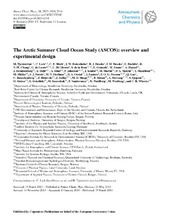The Arctic Summer Cloud Ocean Study (ASCOS): Overview and experimental design
| dc.contributor.author | Tjernström, Michael | eng |
| dc.contributor.author | Leck, Caroline | eng |
| dc.contributor.author | Birch, Cathryn E. | eng |
| dc.contributor.author | Bottenheim, Jan W. | eng |
| dc.contributor.author | Brooks, Barbara J. | eng |
| dc.contributor.author | Brooks, Ian M. | eng |
| dc.contributor.author | Bäcklin, Leif | eng |
| dc.contributor.author | Chang, Rachel | eng |
| dc.contributor.author | de Leeuw, Gerrit | eng |
| dc.contributor.author | Di Liberto, Luca | eng |
| dc.contributor.author | De La Rosa, Sara | eng |
| dc.contributor.author | Granath, Eva | eng |
| dc.contributor.author | Graus, Martin | eng |
| dc.contributor.author | Hänsel, Armin | eng |
| dc.contributor.author | Heintzenberg, Jost | eng |
| dc.contributor.author | Held, Andreas | eng |
| dc.contributor.author | Hind, Andrew | eng |
| dc.contributor.author | Johnston, Paul | eng |
| dc.contributor.author | Knulst, Johan C. | eng |
| dc.contributor.author | Martin, Maria | eng |
| dc.contributor.author | Matrai, Patricia A. | eng |
| dc.contributor.author | Mauritsen, Thorsten | eng |
| dc.contributor.author | Müller, Markus | eng |
| dc.contributor.author | Norris, Sarah J. | eng |
| dc.contributor.author | Orellana, Mónica V. | eng |
| dc.contributor.author | Orsini, Douglas A. | eng |
| dc.contributor.author | Paatero, Jussi | eng |
| dc.contributor.author | Persson, P. Ola G. | eng |
| dc.contributor.author | Gao, Qiuju | eng |
| dc.contributor.author | Rauschenberg, Carlton | eng |
| dc.contributor.author | Ristovski, Zoran | eng |
| dc.contributor.author | Sedlař, Joseph | eng |
| dc.contributor.author | Shupe, Matthew D. | eng |
| dc.contributor.author | Sierau, Berko | eng |
| dc.contributor.author | Sirevaag, Anders | eng |
| dc.contributor.author | Sjögren, Staffan | eng |
| dc.contributor.author | Stetzer, Olaf | eng |
| dc.contributor.author | Swietlicki, Erik | eng |
| dc.contributor.author | Szczodrak, Malgorzata | eng |
| dc.contributor.author | Vaattovaara, Petri | eng |
| dc.contributor.author | Wahlberg, Nils | eng |
| dc.contributor.author | Westberg, Maria | eng |
| dc.contributor.author | Wheeler, Cassie R. | eng |
| dc.date.accessioned | 2015-09-29T13:17:05Z | |
| dc.date.available | 2015-09-29T13:17:05Z | |
| dc.date.issued | 2014-03-19 | |
| dc.Published | Atmospheric Chemistry And Physics 2014, 14(6):2823-2869 | eng |
| dc.identifier.issn | 1680-7324 | en_US |
| dc.identifier.issn | 1680-7316 | en_US |
| dc.identifier.uri | https://hdl.handle.net/1956/10535 | |
| dc.description.abstract | The climate in the Arctic is changing faster than anywhere else on earth. Poorly understood feedback processes relating to Arctic clouds and aerosol–cloud interactions contribute to a poor understanding of the present changes in the Arctic climate system, and also to a large spread in projections of future climate in the Arctic. The problem is exacerbated by the paucity of research-quality observations in the central Arctic. Improved formulations in climate models require such observations, which can only come from measurements in situ in this difficult-to-reach region with logistically demanding environmental conditions. The Arctic Summer Cloud Ocean Study (ASCOS) was the most extensive central Arctic Ocean expedition with an atmospheric focus during the International Polar Year (IPY) 2007–2008. ASCOS focused on the study of the formation and life cycle of low-level Arctic clouds. ASCOS departed from Longyearbyen on Svalbard on 2 August and returned on 9 September 2008. In transit into and out of the pack ice, four short research stations were undertaken in the Fram Strait: two in open water and two in the marginal ice zone. After traversing the pack ice northward, an ice camp was set up on 12 August at 87°21' N, 01°29' W and remained in operation through 1 September, drifting with the ice. During this time, extensive measurements were taken of atmospheric gas and particle chemistry and physics, mesoscale and boundary-layer meteorology, marine biology and chemistry, and upper ocean physics. ASCOS provides a unique interdisciplinary data set for development and testing of new hypotheses on cloud processes, their interactions with the sea ice and ocean and associated physical, chemical, and biological processes and interactions. For example, the first-ever quantitative observation of bubbles in Arctic leads, combined with the unique discovery of marine organic material, polymer gels with an origin in the ocean, inside cloud droplets suggests the possibility of primary marine organically derived cloud condensation nuclei in Arctic stratocumulus clouds. Direct observations of surface fluxes of aerosols could, however, not explain observed variability in aerosol concentrations, and the balance between local and remote aerosols sources remains open. Lack of cloud condensation nuclei (CCN) was at times a controlling factor in low-level cloud formation, and hence for the impact of clouds on the surface energy budget. ASCOS provided detailed measurements of the surface energy balance from late summer melt into the initial autumn freeze-up, and documented the effects of clouds and storms on the surface energy balance during this transition. In addition to such process-level studies, the unique, independent ASCOS data set can and is being used for validation of satellite retrievals, operational models, and reanalysis data sets. | en_US |
| dc.language.iso | eng | eng |
| dc.publisher | Copernicus Publications | en_US |
| dc.rights | Attribution CC BY | eng |
| dc.rights.uri | http://creativecommons.org/licenses/by/3.0/ | eng |
| dc.title | The Arctic Summer Cloud Ocean Study (ASCOS): Overview and experimental design | en_US |
| dc.type | Peer reviewed | |
| dc.type | Journal article | |
| dc.date.updated | 2015-07-28T11:28:51Z | |
| dc.description.version | publishedVersion | en_US |
| dc.rights.holder | Copyright 2014 The Authors | en_US |
| dc.identifier.doi | https://doi.org/10.5194/acp-14-2823-2014 | |
| dc.identifier.cristin | 1154502 | |
| dc.subject.nsi | VDP::Matematikk og naturvitenskap: 400::Geofag: 450::Meteorologi: 453 | |
| dc.subject.nsi | VDP::Mathematics and natural scienses: 400::Geosciences: 450::Meteorology: 453 |
Tilhørende fil(er)
Denne innførselen finnes i følgende samling(er)
-
Geophysical Institute [1187]

